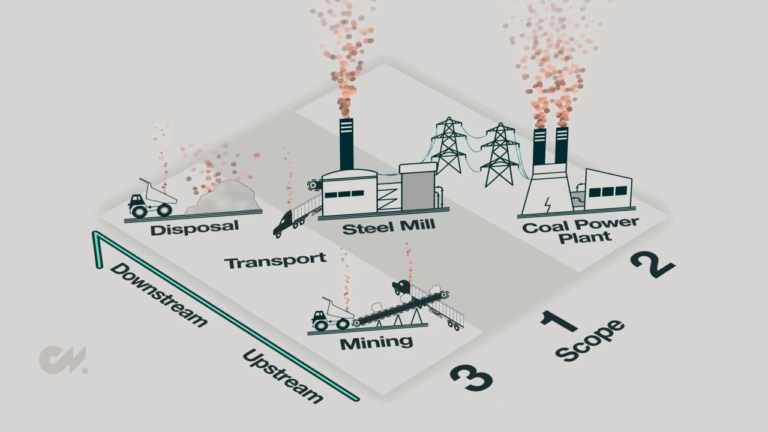Scope 1, 2, and 3 emissions are categories businesses use to measure and report their greenhouse gas emissions, helping them understand and reduce their carbon footprint.
- Scope 1 covers direct emissions from company-owned operations, like fuel burned in company trucks or gas boilers.
- Scope 2 covers indirect emissions from purchased electricity, steam, heating, and cooling that the company uses.
- Scope 3 covers all other indirect emissions across a company’s value chain, like emissions from suppliers, business travel, product use, and waste disposal.
Why Scope 1, 2, and 3 Emissions Matter
- Businesses need to measure all scopes to set real climate goals.
- Investors and consumers increasingly demand transparency.
- Regulators in the EU, California, and other regions are starting to require Scope 3 disclosures.
- Tracking emissions helps identify cost-saving opportunities through energy efficiency and supply chain improvements.
A 2024 report by CDP found that companies disclosing Scope 3 emissions have, on average, 11 times the emissions in Scope 3 as in Scope 1 and 2 combined, underlining why a narrow focus on direct emissions is inadequate for meaningful climate action.
Breaking Down Each Scope in Detail

Scope 1: Direct Emissions
Scope 1 emissions are direct greenhouse gas emissions from sources that a company owns or controls.
Examples
- Fuel is burned in company-owned delivery trucks or vans.
- On-site fuel combustion in gas boilers, heaters, or industrial processes.
- Fugitive emissions like refrigerant leaks from HVAC systems or methane leaks in oil and gas operations.
Examples of Scope 1 Emissions
Source
Emission Example
Company fleet vehicles
CO₂ from diesel or gasoline
On-site combustion
Natural gas is burned in boilers
Refrigerant leaks
Hydrofluorocarbons (HFCs)
Manufacturing processes
CO₂, methane from operations
Scope 2: Indirect Emissions from Purchased Energy
Scope 2: Indirect emissions from purchased energy used to run operations, including factory machinery, lighting, and climate control.
— Component Sense (@ComponentSense) May 12, 2025
Scope 2 emissions are indirect emissions from the generation of purchased electricity, steam, heating, and cooling consumed by the company.
Even though a business doesn’t generate these emissions on-site, it is responsible for the emissions created when energy is produced elsewhere to power its operations.
Examples
- Electricity is used to power offices, warehouses, and factories.
- Purchased steam or heating in manufacturing facilities.
- Cooling systems in commercial buildings.
Scope 2 Emissions by Region (2023)
Region
Average Emission Factor (kg CO₂/kWh)
United States
0.40
European Union
0.28
China
0.61
India
0.71
Scope 3: All Other Indirect Emissions
View this post on Instagram
Scope 3 emissions are all indirect emissions that occur in a company’s value chain, including both upstream and downstream activities.
Scope 3 is typically the largest category of emissions for most businesses, but also the hardest to measure and manage because it involves third parties.
Examples
- Emissions from suppliers producing raw materials.
- Transportation and distribution are not owned by the company.
- Employee business travel and commuting.
- Use of sold products (e.g., gasoline sold by oil companies, electricity used by appliances sold).
- Waste disposal and end-of-life treatment of products.
Common Scope 3 Categories (GHG Protocol)
Category
Example
Purchased goods and services
Emissions from producing raw materials
Capital goods
Emissions from manufacturing equipment purchased
Fuel and energy-related
Upstream emissions from fuel extraction
Transportation and distribution
Third-party shipping emissions
Waste generated in operations
Landfill methane, recycling emissions
Business travel
Flights, car rentals
Employee commuting
Cars, public transport emissions
Use of sold products
Energy used by consumers
End-of-life treatment
Disposal and recycling of products
Why Scope 3 Is Critical
A 2024 McKinsey analysis showed that Scope 3 emissions account for 75%–90% of total emissions in most industries, particularly in retail, consumer goods, and technology sectors.
If companies ignore Scope 3, they are ignoring the majority of their climate impact.
Global Statistics on Emissions by Scope
Sector
Scope 1 & 2 Emissions (%)
Scope 3 Emissions (%)
Consumer Goods
10%
90%
Automotive
20%
80%
Food & Beverage
25%
75%
Technology
15%
85%
How Companies Reduce Emissions by Scope

Reducing emissions across Scope 1, 2, and 3 requires companies to adopt practical strategies aligned with their operational realities, supply chains, and customer needs.
Addressing each scope systematically enables businesses to move from reporting emissions to genuinely reducing them, which is critical for meaningful climate action and future-proofing operations.
Reducing Scope 1 Emissions
Scope 1 emissions come directly from company-controlled activities, including on-site fuel combustion and emissions from vehicles.
One of the most impactful steps companies take is transitioning their vehicle fleets from diesel or gasoline-powered models to electric vehicles, cutting down on direct fuel combustion emissions.
Alongside fleet changes, businesses invest in upgrading boilers and heating systems with energy-efficient models that reduce fuel consumption while maintaining operational performance.
Managing refrigerant leaks through improved monitoring systems is another effective approach, as refrigerants can have a global warming potential thousands of times higher than carbon dioxide when leaked into the atmosphere.
Together, these actions help companies systematically reduce emissions they directly control while often providing long-term cost savings through reduced fuel and maintenance expenses.
Reducing Scope 2 Emissions

Scope 2 emissions are linked to the electricity, heating, cooling, and steam that companies purchase to power their operations. One primary strategy for reducing Scope 2 emissions is switching to renewable energy sources, including solar, wind, and hydropower, either by installing on-site systems or through contracts with green energy suppliers.
Additionally, businesses implement energy efficiency measures across their facilities, such as replacing traditional lighting with LED systems, upgrading insulation, and modernizing HVAC systems to reduce the energy required for heating and cooling.
Companies also participate in green tariffs and renewable energy certificate programs, ensuring that the electricity they consume is offset by investments in renewable energy, effectively reducing the carbon intensity of their power consumption.
These measures not only decrease emissions but also protect companies from energy price volatility in the long term.
Reducing Scope 3 Emissions
Scope 3 emissions, which often account for the majority of a company’s carbon footprint, involve all indirect emissions throughout a company’s value chain, from raw material extraction to product use and disposal.
Reducing these emissions begins with supplier engagement, encouraging and assisting suppliers to adopt cleaner energy sources and improve their operational efficiencies.
Companies also redesign products to consume less energy during their use phase, which significantly reduces downstream emissions, especially for manufacturers of consumer electronics and appliances.
Logistics improvements, including route optimization, transitioning to low-emission transport modes, and consolidating shipments, reduce transportation-related emissions within the supply chain.
Encouraging broader sustainable practices among supply chain partners, such as adopting circular economy models and responsible sourcing, further contributes to reductions in Scope 3 emissions, enabling companies to address the full lifecycle impact of their products and services.
Real-World Example: Apple’s Emissions Strategy
Apple 2030 is our commitment to making all of our products and our supply chain carbon neutral. We’re innovating every day to redefine what‘s possible and to protect this planet we all share. Happy Earth Day! pic.twitter.com/eEEWMWrYwd
— Tim Cook (@tim_cook) April 22, 2023
Apple’s approach to managing emissions offers a clear example of applying reduction strategies across all scopes. In 2023, Apple disclosed that only 2% of its emissions fell under Scope 1 and Scope 2, while an overwhelming 98% were categorized as Scope 3, primarily resulting from manufacturing activities and product use by customers.
To address Scope 2 emissions, Apple has transitioned to using 100% renewable energy for all its offices, data centers, and retail stores globally. This move directly reduces emissions associated with the electricity required for its operations.
In addressing Scope 3 emissions, Apple actively works with its suppliers to help them transition to renewable energy sources and energy-efficient practices, recognizing that emissions generated during the production of its devices constitute a significant portion of its carbon footprint.
Additionally, Apple focuses on designing its products for energy efficiency, reducing emissions during the use phase by customers, and ensuring its products contribute to a lower carbon impact throughout their lifecycle.
Why Consumers Should Care
Understanding Scope 1, 2, and 3 emissions is not just relevant for companies; it holds significance for consumers as well. The emissions generated during the manufacturing, transportation, and disposal of products often result in hidden environmental costs, which can be passed on to consumers through the price of goods and services.
By supporting brands that actively disclose and reduce emissions across all scopes, consumers can drive demand for cleaner, more responsible products, encouraging industries to adopt sustainable practices.
Consumers also have a direct role in reducing emissions by making informed purchasing choices. Choosing energy-efficient appliances, buying products from companies with strong sustainability commitments, and supporting businesses that prioritize supply chain decarbonization contribute to reducing Scope 3 emissions across industries.
These actions collectively influence market dynamics, pushing more companies to align with sustainability goals and support the broader transition to a low-carbon economy.
Emissions by Scope: Comparative Table
To clearly illustrate the scope of emissions and company action areas, the following table provides a practical comparison:
Scope
Description
Examples
Reduction Strategies
Scope 1
Direct emissions from owned or controlled sources
Fuel combustion in company vehicles, emissions from boilers, and refrigerant leaks
Transition to electric fleets, upgrade to efficient equipment, and prevent leaks
Scope 2
Indirect emissions from purchased energy
Electricity, heating, and cooling
Switch to renewable energy, improve energy efficiency, and green tariffs
Scope 3
All other indirect emissions across the value chain
Supplier emissions, product use, logistics, waste disposal
Supplier engagement, product redesign, logistics optimization, and circular practices
Last Words
@sustainabilitytrackerWhat are scope 1, 2 and 3 emissions, anyway? New episode 🎙️ South Pole | Why we must fund climate action In this episode, Kiarne dives into some of the most commonly asked climate questions with Tara Oakley, the Head of Commercial – Oceania at South Pole. Tara provides the ultimate carbon crash course for anyone interested in sustainability in business. Tara unpacks the nuances of carbon credits, offsetting, and discusses the growing movement away from the ‘carbon neutral’ claim. Plus, she addresses the recent media attention raising questions around the integrity of carbon projects. That’s a wrap on season one! Listen and subscribe with the link in bio so you don’t miss out when we launch season two!♬ original sound – Sustainability Tracker
Scope 1, 2, and 3 emissions frameworks enable businesses and consumers to understand, measure, and reduce the climate impact of products and operations comprehensively. Scope 1 covers emissions directly under company control, such as vehicles and facilities.
Scope 2 focuses on the emissions associated with the energy a company uses, while Scope 3 includes all other emissions across the supply chain, from sourcing to end-of-life disposal.
In an era of accelerating climate change and increasing regulatory requirements, managing and reducing emissions across all scopes is no longer optional.
It is a critical pathway to achieving real, measurable climate action while building resilient, future-ready businesses and providing consumers with the confidence that the products they choose support a sustainable economy.

